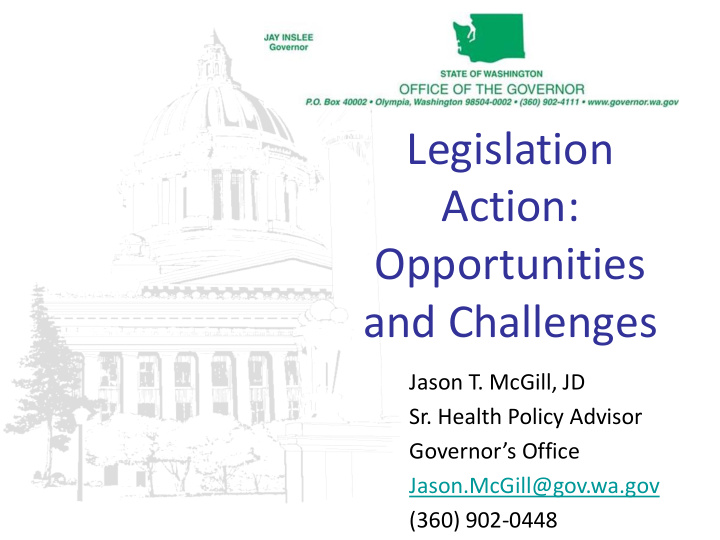



Legislation Action: Opportunities and Challenges Jason T. McGill, JD Sr. Health Policy Advisor Governor’s Office Jason.McGill@gov.wa.gov (360) 902-0448
Opioid crisis response – Governor’s Executive Order Goal 1 : Prevent inappropriate opioid prescriptions and use Goal 2 : Treat people with opioid use disorder and connect them to support services, including housing Goal 3 : Save lives by intervening in overdoses Goal 4 : Use data to focus and http://www.governor.wa.gov/sites improve our work /default/files/exe_order/OpioidEp idemic.pdf
Goal 1: Prevent inappropriate opioid prescriptions and use • Prevent the next generation of pain patients from using opioids if they don’t need to by amending practice guidelines for prescribing providers with a focus on limiting adolescent prescriptions. • Use proven strategies for prevention education. We will develop a communication strategy geared to youth, to patients and to the community, and use our existing safe drug storage and disposal programs (e.g. drug take-back programs) to distribute prevention information. • Expand tele-mentoring programs, such as UW TelePain and begin a pharmacy hotline program. • Decrease the supply of illegal opioids like heroin and Fentanyl in our state. The Attorney General’s Office will convene a summit in partnership with the Washington State Patrol and prosecutors, courts, and local and federal law enforcement agencies to develop strategies.
Goal 2: Treat people with opioid use disorder and link them to support services, including housing • Support and implement behavioral health integration strategies and center of excellence models. This includes screening for opioid use disorder in primary care and increasing medication-assisted and other treatments in a culturally appropriate and accessible manner. • Ensure availability of rapid, low-barrier access to treatment medications for people with opioid use disorder, especially pregnant women, intravenous drug users and those who are homeless. Explore new and existing funding sources to increase capacity in syringe exchanges and other evidenced-based programs. • Ensure recently released offenders with opioid use disorder are connected with care. • Reduce insurance and state program coverage barriers for treatment and services related to effective pain management, opioid use disorder and naloxone.
Goal 3: Save lives by intervening in overdoses • Educate opioid users and others on how to respond to an overdose and make sure those who are covered by Medicaid receive overdose education and access to naloxone. • Consider centralizing naloxone for bulk purchasing for public health use to increase availability.
Goal 4: Use data to focus and improve our work • Develop statewide measures to help better detect unsafe prescribing practices and identify patients at high risk of opioid use disorder. • Explore ways to improve functionality and use of the Prescription Drug Monitoring Program among health care providers. • Explore methods to notify health care providers when a patient has an opioid overdose event.
2017 Legislation
Opioid crisis response – 2017 Legislation introduced: • HB 1426/SB 5248: improves use of the prescription drug monitoring program (amends Chapter 70.225, Prescription Monitoring Program). • HB 1339: 7-day supply for first time patient; dentists 3-day supply (amends Legend Drug Act – Chapter 69.41 RCW) • HB 1427: implements updates to Community Mental Health Services Act (Chapter 70.24 RCW) improvements following taskforce recommendations. • HB 1047: Creating a system for safe and secure collection and disposal of unwanted medications (aka Drug take-back). • HB 1505: Naloxone Access Grant Program – imposes a fee on the wholesale distributor of prescription opioids and pays for distribution, training and education of Naloxone. • SB 5223/HB 1761: Preempts local regulations to prohibit safe injection sites in Washington State.
PASSED HB 1427 – Opioid treatment • Modifies the standards for siting opioid treatment programs. • Modernizes some terminology in statute and legal/court forms and declarations regarding treatment for opioid use disorder. • Requires fair treatment of people lawfully possessing or using medication, including medication assisted treatment, in judicial and administrative proceedings. • Expands access to the Prescription Monitoring Program (PMP) and allows the Dept. of Health to distribute data from the program to providers for quality improvement purposes (like reports to providers so they know where they stand). • Requires prescribing boards and commissions to update practice rules establishing requirements for prescribing opioid drugs.
Funding
1115 Medicaid Demonstration Waiver $1B+ federal funding See toolkit for what providers can do to qualify for funding – basically integrate care, use care coordination, implement clinical guidelines and make practice changes, offer MAT: https://www.hca.wa.gov/sites/default/files/program/medicaid-transformation-toolkit.pdf
Federal Grant: State Targeted Response (STR) to Opioid Crisis $11,790,256 per year/Two year grant. Primary and Secondary Prevention $2,155,768 Public Education Campaign ($868,149) Community Prevention and Wellness Initiative (CPWI) Expansion ($752,000) Treatment/Recovery Expansion $9,044,975 Hub and Spoke ($4,995,951) Mobile OTP Van ($400,000) Low-Barrier Buprenorphine Pilot ($130,000) Prescription Monitoring Program ($250,000) Grant overview: https://www.dshs.wa.gov/sites/default/files/BHSIA/dbh/ Fact%20Sheets/WA_STRGrant_Overview.pdf
Recommend
More recommend